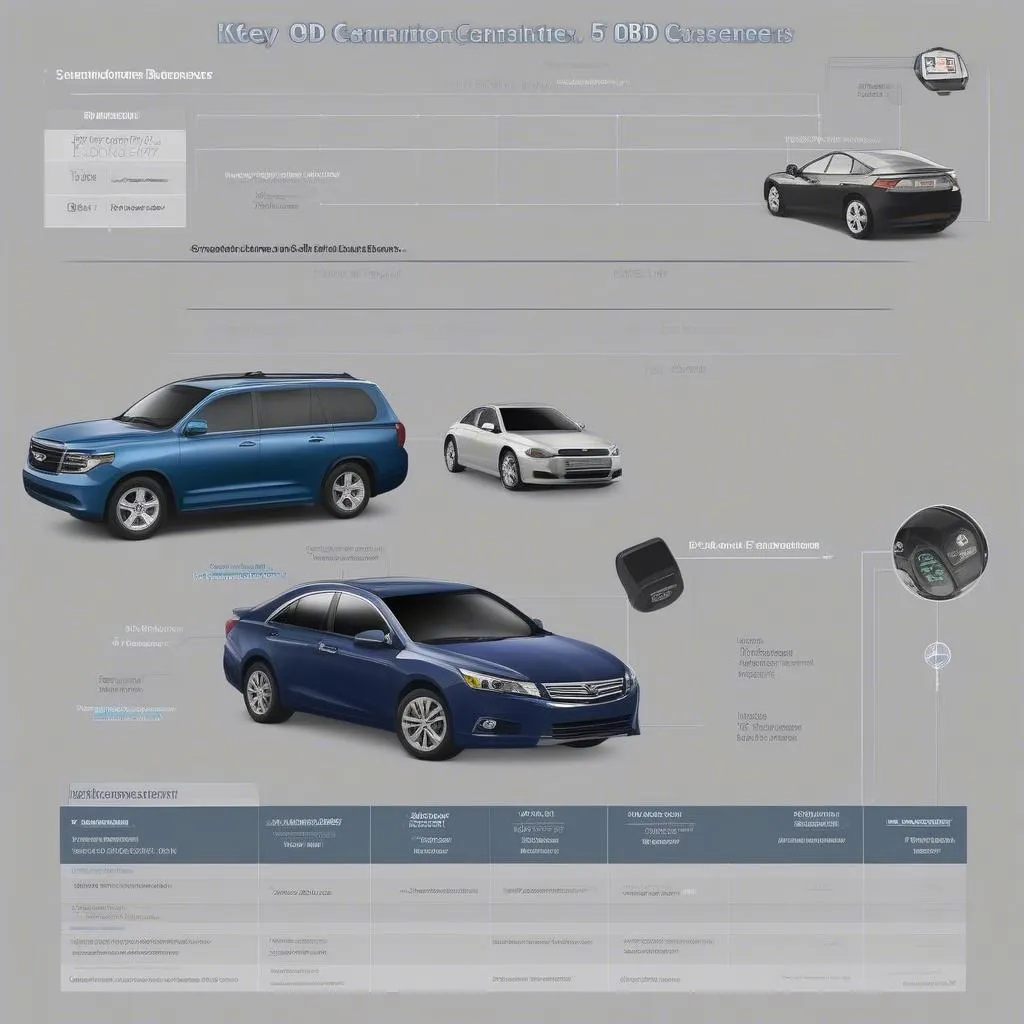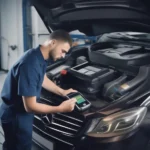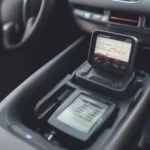Choosing the best overall OBD2 scanner can feel overwhelming with countless options flooding the market. Whether you’re a seasoned mechanic or a car enthusiast looking to delve into DIY repairs, having a reliable diagnostic tool is essential. This comprehensive guide will walk you through everything you need to know about OBD2 scanners, helping you make an informed decision and find the perfect fit for your needs.
Understanding OBD2 Scanners: What They Do and Why You Need One
OBD2 scanners, also known as vehicle diagnostic scanners, are handheld devices that connect to your car’s OBD2 port, typically located under the dashboard. This port acts as your car’s data center, storing information about your engine, transmission, emissions system, and more. By plugging in an OBD2 scanner, you can access this data and:
- Read and clear diagnostic trouble codes (DTCs): When your car’s check engine light illuminates, it means the onboard computer has detected a problem and stored a DTC. An OBD2 scanner decodes these codes, providing insights into the issue’s nature and potential causes.
- Monitor live data streams: View real-time information about your car’s performance, such as engine RPM, coolant temperature, oxygen sensor readings, and more. This feature is invaluable for diagnosing intermittent problems or monitoring specific parameters while driving.
- Perform advanced diagnostics: Depending on the scanner’s capabilities, you can access manufacturer-specific codes, run component tests, reset service reminders, and even perform ECU coding on certain vehicles.
Investing in a quality OBD2 scanner empowers you to:
- Save money on repairs: By understanding the problem beforehand, you can avoid unnecessary trips to the mechanic and potentially tackle some repairs yourself.
- Prevent costly breakdowns: Regularly scanning your car can reveal minor issues before they escalate into major problems requiring expensive repairs.
- Gain peace of mind: Knowing you have a reliable tool to diagnose car troubles offers peace of mind, especially during long journeys or when purchasing a used vehicle.
Key Features to Consider When Choosing an OBD2 Scanner
With a vast range of OBD2 scanners available, each offering varying functionalities and price points, it’s crucial to prioritize your needs and understand the key features to look for:
1. Compatibility: Ensuring Your Scanner Works With Your Car
Before delving into advanced features, ensure the scanner is compatible with your vehicle. While all 1996 and newer cars sold in the US are OBD2 compliant, some scanners might have limitations with specific makes or models.
- Check for manufacturer-specific coverage: Some scanners excel at diagnosing specific brands like Ford, GM, or Toyota.
- Consider the vehicle’s age: Older OBD2-compliant cars might require scanners with specific protocols.
2. Functionality: From Basic Code Reading to Advanced Diagnostics
- Basic Code Readers: Entry-level scanners ideal for reading and clearing DTCs, perfect for casual users.
- Enhanced Code Readers: Offer additional features like live data viewing and freeze frame data for deeper insights.
- Professional-Grade Scanners: Provide comprehensive functionalities, including bi-directional controls, advanced coding, and access to manufacturer-specific systems, catering to experienced mechanics.
3. User Interface: Intuitive Design and Easy Navigation
A user-friendly interface can make or break your diagnostic experience. Look for scanners with:
- Clear and easy-to-read displays: Opt for scanners with color displays for enhanced visibility and intuitive navigation.
- Logical menu structures: A well-organized menu system allows for quick access to desired functions.
- Helpful on-screen prompts and definitions: Scanners with built-in code definitions and troubleshooting tips prove invaluable for DIYers.
4. Connectivity: Wireless Freedom or Wired Reliability
- Bluetooth OBD2 Scanners: Connect wirelessly to your smartphone or tablet, offering convenience and portability.
- USB OBD2 Scanners: Connect directly to your computer, providing a reliable connection and often faster data transfer speeds.
5. Software and Updates: Staying Current for Optimal Performance
Regular software updates are crucial for ensuring compatibility with newer vehicle models and accessing the latest features.
- Check for update frequency and ease of installation: Choose scanners with regular updates and a user-friendly update process.
- Consider subscription-based services: Some manufacturers offer subscription-based software that unlocks additional functionalities and provides access to comprehensive repair databases.
Autel AL539 OBD2 Scanner: Best Overall.
Finding the Right OBD2 Scanner for Your Needs
Choosing the best overall OBD2 scanner depends on your specific requirements and budget. Consider these popular categories:
1. Best for Basic Diagnostics: Budget-Friendly Code Readers
Ideal for casual users seeking to read and clear check engine lights, these scanners offer basic functionality at an affordable price.
2. Best for DIY Enthusiasts: Enhanced Code Readers with Live Data
Empower DIYers to perform more in-depth diagnostics with features like live data streaming and freeze frame data retrieval.
3. Best for Professional Mechanics: Comprehensive Diagnostic Tools
Professional-grade scanners provide access to advanced functionalities, manufacturer-specific codes, bi-directional controls, and coding capabilities.
Frequently Asked Questions (FAQs)
1. What is the OBD2 port and where can I find it?
The OBD2 port, also known as the diagnostic link connector (DLC), is a standardized 16-pin connector typically located under the dashboard on the driver’s side.
2. Will any OBD2 scanner work with my car?
While all 1996 and newer cars sold in the US are OBD2 compliant, it’s crucial to check the scanner’s compatibility with your specific make, model, and year.
3. Can I use an OBD2 scanner to reset the check engine light?
Yes, most OBD2 scanners allow you to clear diagnostic trouble codes (DTCs), which will turn off the check engine light. However, it’s essential to address the underlying problem that triggered the light in the first place.
4. What is the difference between a code reader and a scan tool?
While often used interchangeably, “code reader” typically refers to basic scanners that only read and clear DTCs. “Scan tools” usually offer more advanced functionalities like live data viewing, freeze frame data, and bi-directional controls.
5. Do I need a professional mechanic to use an OBD2 scanner?
Not necessarily. Many OBD2 scanners, especially those designed for DIYers, come with user-friendly interfaces and built-in code definitions, making them easy to use even for beginners.
Conclusion
Finding the best overall OBD2 scanner empowers you to take control of your car’s health, saving you time and money on repairs. By understanding the key features, exploring different categories, and considering your specific needs, you can confidently choose a scanner that will serve you well for years to come.
Remember, investing in a quality OBD2 scanner is an investment in your car’s longevity and your peace of mind on the road. For personalized assistance in choosing the perfect scanner for your needs, don’t hesitate to reach out to our expert team through WhatsApp: +1(641)206-8880 or Email: [email protected]. We offer 24/7 customer support to address any questions or concerns you may have.


